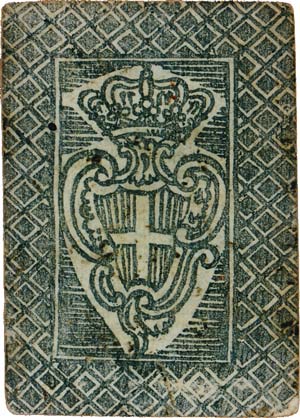Malta
The so-called ‘Dragon Cards’, with winged monsters on the four Aces, are an enigmatic aspect of early playing card history.
Maltese ‘Dragon Cards’

Above: a unique, complete set of 40 playing cards printed during the reign of Grandmaster de Rohan (1775-1797), stencil-coloured in yellow, red, then green. The four Kings are seated on thrones and have Maltese crosses of the Order of St John on their breasts. The Four of Coins is stamped with the coat-of-arms of the grandmaster. The verso of the cards shows the Order's escutcheon. The cards were made into pasteboard and the back paper is folded round to form a border around the front. Cards measure 85x60mm.
The so-called ‘Dragon Cards’, with winged monsters on the four Aces, are a colourful and somewhat enigmatic aspect of early playing card history. The earliest known examples are Spanish from about 1550 and the latest surviving descendents can be seen in Japanese mekuri cards today. At various times cards of this type have appeared in Italy, Portugal, Malta and elsewhere in Europe, and their influence has been noted in cards from Japan, Brazil, India and Indonesia. Cards of this type were also discovered in archaeological digs in Peru, having been taken there by Spaniards.
The inscriptions at the tops and bottoms of the cards shown here suggest an Italian model (rather than Spanish) and the cards closely resemble late seventeenth century Italian cards known as ‘Infirrera’ cards, after the name of the maker. Earlier examples of similar cards also found in Malta suggest that they were being printed and assembled in Malta since the seventeenth century. The Kings have Maltese crosses of the Order of St John on their breasts which is curious since any form of gambling was not permitted in the Order. However, the Four of Coins is stamped with the coat-of-arms of the grandmaster which could indicate his approval.
REFERENCES
Denning, Trevor & Schirò, Joseph: ‘Maltese Dragon Cards’ in The Playing-Card, journal of the International Playing-Card Society, Volume 30 No.1, July/Aug 2001, pp.33-42.
Schirò, Joseph & Lupi, Theresa Zammit: ‘The conservation and preservation of rare ‘dragon’ playing cards’ in The Paper Conservator, Volume 27, Issue 1, 2003.
See also: Francisco Flores • Cards discovered in Peru • Early Spanish/Portuguese Cards • Dragon Cards from Portugal • Belgian 'Dragon' Cards (Mesmaekers Frères) • Belgian 'Dragon' Cards (Léonard Biermans) • Tensho Mekuri • Japanese Akahachi • Japanese Kurofuda • Japanese Kabufuda.

By Simon Wintle
Member since February 01, 1996
I am the founder of The World of Playing Cards (est. 1996), a website dedicated to the history, artistry and cultural significance of playing cards and tarot. Over the years I have researched various areas of the subject, acquired and traded collections and contributed as a committee member of the IPCS and graphics editor of The Playing-Card journal. Having lived in Chile, England, Wales, and now Spain, these experiences have shaped my work and passion for playing cards. Amongst my achievements is producing a limited-edition replica of a 17th-century English pack using woodblocks and stencils—a labour of love. Today, the World of Playing Cards is a global collaborative project, with my son Adam serving as the technical driving force behind its development. His innovative efforts have helped shape the site into the thriving hub it is today. You are warmly invited to become a contributor and share your enthusiasm.
Related Articles

French Revolutionary cards by Pinaut
Seven cards from a French Revolutionary pack by Pinaut featuring characters from classical antiquity...

Trappola cards from Poland
Trappola cards published in Warsaw by J G Du Port during the 18th century.

Laurenzo Propagine
Spanish-suited cards made in Italy by Laurenzo Propagine.

Trek Deck Malta Vol. 1
Innovative pack describing 52 different treks around Malta, Gozo and Comino.

Portuguese pattern by Real Fábrica
Later Portuguese pattern by Impressão Règia, Real Fábrica de Lisboa.

Rouen Pattern - Portrait Rouennais
An attractive XV century French-suited design from Rouen became the standard English & Anglo-America...

Archaic Spanish proof sheets
2 x uncoloured proof sheets of archaic Spanish-suited playing cards produced for “New Spain”, possib...

Ganjifa - Playing Cards from India
Indian playing cards, known as Ganjifa, feature intricate designs with twelve suits and are traditio...

The Henry Hart Puzzle
Explore the intricate history and unique design variations of Henry Hart's playing cards, tracing th...

Sevilla 1647 reproduction
Facsimile of Spanish-suited pack produced in Sevilla, Spain, 1647.

Why our playing-cards look the way they do
Analysis of early playing card designs: origins, suit differences, standardization, technological ad...

Introduction to Collecting Themes
Playing cards can be broadly categorised into standard and non-standard designs, with collectors app...

Le Monde Primitif Tarot
Facsimile edition produced by Morena Poltronieri & Ernesto Fazioli of Museo Internazionale dei Taroc...

Burgundy pattern - portrait bourguignon
The old Burgundy (or Burgundian) pattern by Nicolas Chenevet, Dijon.

Trappola pack by Joseph Fetscher
Trappola pack published by Joseph Fetscher, Graz, 1739.

Lyon pattern by Michel Ressy
Lyon pattern by Michel Ressy, c.1760.
Most Popular
Our top articles from the past 28 days





